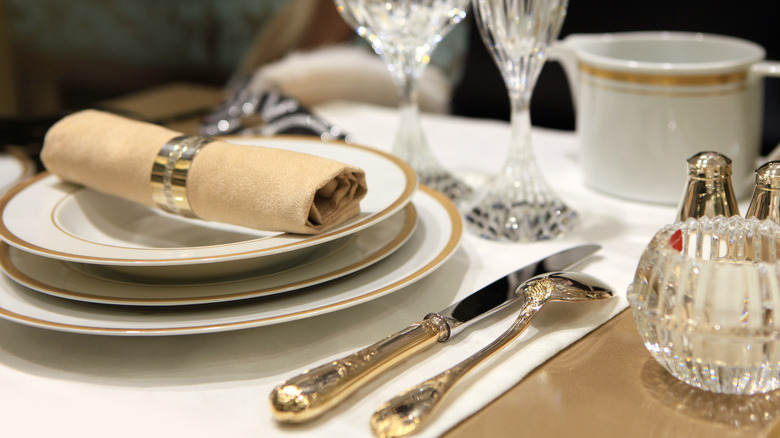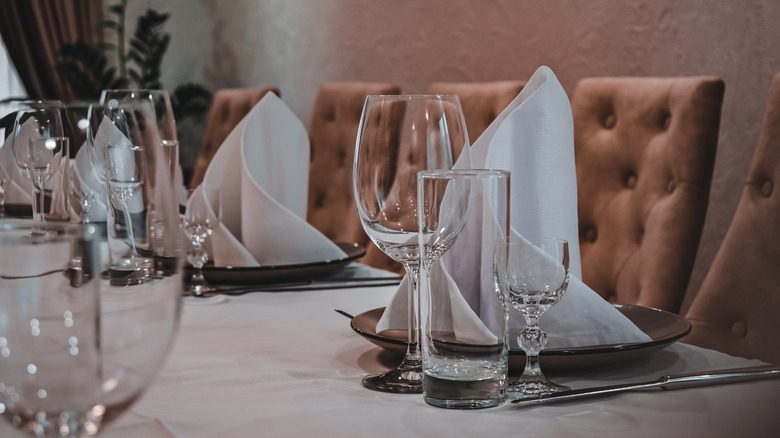The Difference Between Table Manners And Dining Etiquette
Etiquette and manners are certainly related, but they are also distinctly different. Manners are essentially learned behaviors — like saying please and thank you, or keeping your mouth closed while chewing — that exist within a much larger societal code of conduct known as etiquette.
According to Emily Post, the woman who helped to codify etiquette and manners in America with her landmark 1922 book, "Etiquette in Society, in Business, in Politics, and at Home," and whose family-run institute continues to be an arbiter of all things right and proper, the principles of etiquette are eternal. Thus, fundamental precepts like being respectful and considerate of others are always in style. Manners, on the other hand, can and do change with the times. Keeping one's elbows off the dinner table, for example, was once considered a no-no, but is now acceptable in most circumstances.
The relationship between table manners and dining etiquette is the same — at least in the sense that the latter is concerned with ethical conduct in a social situation while the former provides the actual framework for behaving properly. Knowing the dos and don'ts of good manners in a fine dining setting – proper napkin usage, for instance — ensures that you will meet the expectations of your fellow guests in regard to proper conduct, meaning the rules of etiquette.
Historical origins of fine dining etiquette and table manners
Although Emily Post insisted that an etiquette philosophy of respect and consideration never goes out of style, for much of its history, etiquette has also been used to reinforce class distinctions. When table manners were exalted during the Renaissance, for example, it was partly as a preventative to violence, but also as a means of classing off the privileged elite from the general public. The word etiquette, in fact, was invented at French king Louis XIV's luxurious palace at Versailles, and the idea of rigidly defined codes of conduct, and elaborate table manners, were almost exclusively the preserve of the aristocracy prior to the 18th century.
As the middle class became more powerful in Europe during the 18th century, many from this class acquired wealth and social prominence. Their acceptance by the upper classes, however, was premised on learning proper etiquette. Thus, upward mobility became associated with learning how to behave properly. This class component was prevalent in the U.S. as well since the first etiquette manuals were based on British models. It wasn't until Emily Post began writing in the early 20th century that etiquette and manners became more inclusive. Although Post herself was from a wealthy family, her admonitions on topics such as table manners were aimed at society at large.
How fine dining etiquette and table manners work in harmony
Once fine dining etiquette in the U.S. became premised on respect and consideration rather than elaborate social rituals – think lots of different kinds of forks — designed to reveal one's class status, table manners became a bit more commonsensical. For example, one of the accepted etiquette rules in contemporary fine dining is that diners follow the cues given by their hosts. This etiquette rule is reflected in numerous table manners, from the way you're expected to order (avoid overly expensive dishes can help you avoid an awkward business lunch) to the proper times to remove your napkin from the table.
Table manners that were more ritualized, and don't necessarily make sense in contemporary society, are gradually being filtered out. The elbows on the table rule is seldom observed these days, as are former table manners standards like keeping the menu in contact with the table and pushing uneaten food to one specific part of the plate (it's the upper left if you were wondering). What's most important is respect for one's fellow diners, and manners that reflect this have remained relevant.
A few new table manners have been introduced in response to technology. Emily Post, for instance, confirms that making or receiving phone calls in a restaurant's dining room is a definite no-no. But as always, such table manners are a reflection of larger etiquette principles, yet they remain somewhat distinct: Manners are learned from social cues while etiquette is a specific set of rules one learns from instruction, usually indicating one's class or status.



